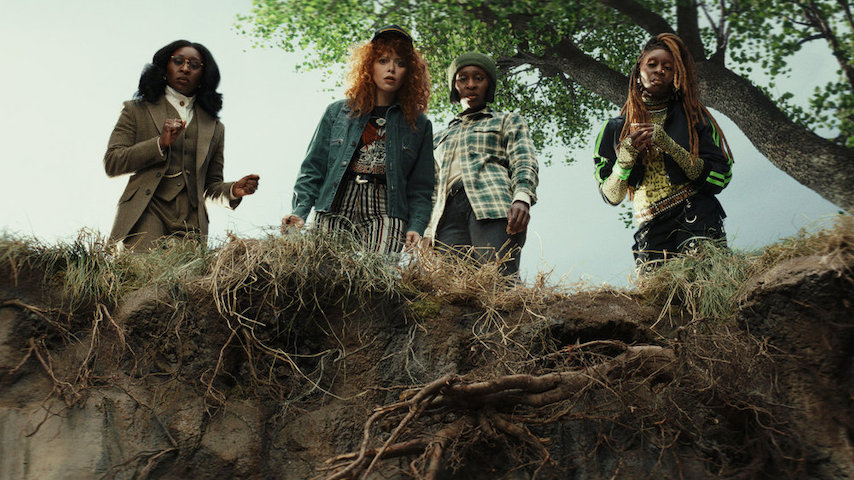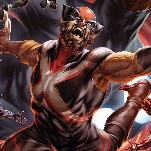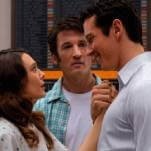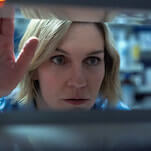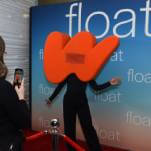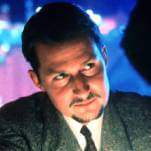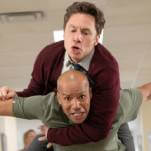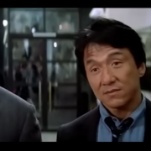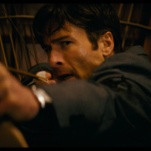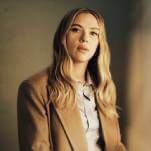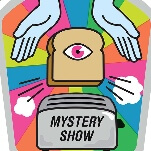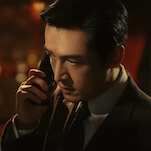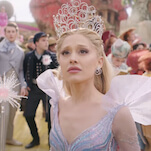Long before Poker Face debuted, Columbo fans on Twitter would sometimes wish-cast who might play the rumpled detective if someone ever tried to remake that show. Natasha Lyonne’s name was floated often. With her raspy voice, stooped posture and affable demeanor, Lyonne’s screen presence is already Peter Falk-like. Why not just lean into it?
Yet what made Poker Face’s first season such a delight—and continues in the first three episodes of season two—is that Lyonne and the series’ creator Rian Johnson didn’t remake Columbo. They brought some of the shaggy retro vibes of ’70s-detective TV, sure. But Poker Face is at heart more of a funky dark comedy, about a one-of-a-kind weirdo: Charlie Cale, who is just trying to lay low in a world filled with killers and liars.
And Lyonne hasn’t just been doing Falk. She’s also Dick Van Dyke, Jacques Tati, and Harpo Marx. She’s a gangly/graceful wonder, filling every space she’s in with her shock of curly red hair, her rubber-band limbs, and her unabashedly toothy grin.
Poker Face‘s three-episode season-two premiere is a little like a speedrun through everything that worked so well in season one, with each installment serving as a handy reminder of why fans dig this series. We get one episode that plays around with Charlie’s “human lie detector” superpower, one that lets Lyonne indulge her own fascination with the artificiality of filmmaking itself, and one about Charlie’s beef with the mafia (with a welcome twist at the end).
We kick off the new run with “The Game Is A Foot,” directed by Johnson and written by Laura Deeley. Cynthia Erivo plays quintuplets—four of whom were child stars, taking turns playing the lead character on the hit show Kid Cop Nights as “the Kazinsky sisters.” The fifth sister, an accomplished mixed-media artist named Felicity Price, was completely unknown to three of the other four, until their mother Norma (Jasmine Guy) died and left the family fortune—amassed from her children’s labor—to Felicity.
Amber, the quintuplet who spent most of her adult life catering to Norma’s cruel whims, learned about Felicity shortly before their mom’s death and concocted a plan. She gives herself a makeover to look like Felicity, leaves a suicide message for her sisters as Amber, then pushes Felicity off of a cliff, making it appear as though Amber has followed through on her threat. Then Amber shows up at the reading of the will as Felicity.
Got all that? It’s a lot to keep track of, but the multiple Erivo performances—coupled with Norma’s enormous seaside estate and Charlie’s inability to let anyone lie—makes for an episode that plays halfway between a broad farce and a drawing-room mystery.
As was common in season one, “The Game Is A Foot” deploys a “circle back” structure, where we spend some extended time with the killer and victim, then the episode circles back to catch us up with what Charlie has been up to—which often, in unexpected ways, shadows the action we’ve already seen. In this case, Charlie’s been working at an apple orchard with Delia Kazinsky. She comes with Delia to the reading of the will—and to the discovery of “Amber’s” corpse.
There are clever twists galore. Amber’s plan to kill and then impersonate Felicity is complicated when it turns out that Felicity has a prosthetic leg. (Amber tries to cover this up by dragging the corpse to a railroad track, so it’ll look like a train severed the leg… though she can’t really explain why the severed part is missing.) And her plan to keep the other sisters from contesting Felicity’s inheritance—by giving them all $150K—hits a snag when Delia refuses to take the deal.
And when Amber tries to fix this new problem by impersonating Delia…? Well, that’s when Charlie’s superpower comes in. One of the challenges that Johnson, Lyonne, and the Poker Face writing staff had to overcome in season one was that Charlie is, as gamers would say, pretty over-powered. If she can always tell when someone’s lying, then it’s not that hard for her to catch a killer, is it? By the end of the first season, the writers found ways to make it so that lie-detecting alone couldn’t always solve everything. The same is true here, as Amber’s multiple impersonations flummox Charlie. Just about everything Amber says—no matter who she’s pretending to be—registers as a lie.
Tip a cap to Erivo, who seems to be having a ball playing multiple Kazinskys—and sometimes playing a Kazinsky pretending to be another Kazinsky. In a scene where Charlie challenges the fake Felicity’s broad southern accent (like “dinner theater Blanche DuBois”), Erivo delivers a remarkable monologue, describing a hard childhood while changing accents pointedly throughout, illustrating Amber’s new philosophy of life: “You must kill the old you to birth the new you.”
Charlie’s able to upend Amber in an old-school drawing-room solution scene, where she plays Poirot, piecing clues together. Amber’s lifelong love of spangles and the phrase “butt-munch” help expose her impersonation of Felicity—and it doesn’t help that Charlie had learned about Felicity’s missing leg. (It turns out that all of Felicity’s art was foot-related, from her “Five Dollar Subway” sculpture to her painting of Footloose star Kevin Bacon.) Charlie proves Amber’s Felicity fakery by dropping the Kazinskys’ very pointy Latvian Critic Award—Best Intergenerational Kiss! They won it five times in a row!—onto her very real foot. (“Holy butt-munching shit!” she exclaims, while spurting blood and collapsing to the floor.)
Charlie flees immediately after this case is cracked, because mob goons are still on her tail. The second episode, “Last Looks,” finds her in Florida and relaxed enough to spend more time out in the open. That’s how her 1969 Plymouth Barracuda is spotted by Tommy (Kevin Corrigan), a location manager working for a low-budget horror movie set in 1973. Charlie’s more than happy to get paid for loaning out her car—and happy to make a few extra bucks playing a corpse.
But then she makes friends with Greta (Katie Holmes), the dissatisfied wife of the joyless Fred Finch (Giancarlo Esposito), who owns and operates the funeral home where this movie’s being shot. When Greta suddenly disappears, Charlie is certain her husband killed her—even though everything he says is just true enough that it doesn’t make her inner lie detector ping.
“Last Looks” was directed by Lyonne, who also co-wrote the script with Alice Ju. That same team produced season one’s “The Orpheus Syndrome,” a stylish mystery set in the world of motion-picture special effects. This episode is similarly moody, using the shooting of a horror movie as an excuse for a lot of skewed angles and deep shadows.
The crime also makes good use of the setting. The movie features a scene where a man clubs his wife over the head, splattering blood everywhere. So late at night Fred kills Greta the same way, cremates her body, and then lets the film crew clean up the remaining mess—which looks just like the kind of mess they made—in the morning.
As always, there are fun details scattered throughout this episode, nearly all of which end up having some relevance. Fred makes extra revenue turning loved ones’ remains (do not say “ashes”) into keepsakes, including coffee mugs, fireworks, and vinyl records. He has long planned to press Greta’s remains into a recording of the classic dreamy instrumental “Sleep Walk”—although she would much prefer “Ring My Bell”—and it’s when Charlie sees and hears Fred dancing alone in his office to “Sleep Walk” that she first seriously suspects foul play. She also spots a drop of blood that the film crew didn’t clean up and knows from her time as a fake corpse that it has to be real.
“Last Looks” has an ending befitting an episode about a horror movie. Fred chloroforms Charlie and puts her in a coffin, ready for cremation. But she escapes and tosses her vape cartridge into the fire—having seen earlier that batteries should be kept out of there—creating an explosion that sets the various undertaker chemicals alight, burning down this spooky house. (Some of the fireworks explode too. Again: Everything’s relevant.)
Charlie is terrified and emotionally drained when she scurries into her Barracuda to drive away from the inferno. That’s when she sees mob boss Beatrix Hasp (Rhea Pearlman) in the backseat with a gun.
This brings us to “Whack-A-Mole,” the final episode of this trifecta and in some ways the weakest—though for the most part all three are consistently entertaining. Director Miguel Arteta and screenwriter Wyatt Cain play with the Poker Face formula a little here, beginning right where the last episode left off, with Beatrix holding Charlie hostage. The whole first act is spent with these two, setting up the plot and springing a twist.
The situation is this: Beatrix’s business is collapsing, and she’s about to flee the country with her foodie husband Jeffrey (Richard Kind), but is worried about an informant within her crew. She wants Charlie to find out who it is. Charlie, still shaken up from barely escaping being burned alive, is unusually terse and down to business. (She sits down with Beatrix’s guys and immediately asks, “So, any of you guys working for the feds?” None are.) Beatrix then makes Charlie accompany her to the airstrip, where before she can get to her private plane the FBI rushes in and shoots Jeffrey dead.
It’s only then that we “circle back”—except this time, we’re catching up with the FBI. We reconnect with an old friend from season one: Agent Luca Clark (Simon Helberg). And we meet the milk-swigging, ulcerous Daniel Clyde-Otis (John Mulaney), who is Beatrix’s mole, inside the FBI. Luca’s mole is Jeffrey (which Charlie realizes and chooses not to expose). Luca plotted with Beatrix’s husband to fake his death with blanks.
Alas, the fakery fails. Thanks to an FBI lip-reader, Danny learns about Luca and Jeffrey’s plan and puts live rounds in place of the first few blanks. In the confusion that follows, Charlie opens up a line of communication with Luca, and Beatrix offers to give up her mole in exchange for witness protection. The only problem is that she doesn’t know his name. She knows he’s a white guy, medium build, thirties to fifties, which…describes pretty much every fed at that airfield. (Luca: “We have some serious flaws with our hiring process.”)
“Whack-A-Mole” ends with Danny arrested, Beatrix in WITSEC, and the hit on Charlie called off—perhaps just in time. This third episode has its highs, but it also reveals how the hunted Charlie is less fun to be around than the wide-eyed, “life’s an adventure” Charlie.
There are still seven episodes left this season—and an impressive list of guest stars set to appear—so I’m sure she’ll keep moving from place to place and murder to murder. After all, that’s what makes this show go. It’s somehow both formulaic and eclectic. It follows the interests of its co-creator and star—and, god bless her, she is interested in a lot.
Stray observations
- • We get a brief look at Charlie’s jobs prior to meeting Delia, and they include working at a parking lot with a guy who kills time reading Erica Jong’s Fear Of Flying (“Very second wave,” he says) and a gig at a haunted hayride, playing a zombie mummy.
- • When Charlie wonders who would steal a foot, a cop suggests, “Wild boars? Passing hobos, riding the rails? Seagulls?”
- • The very idea that a dopey kids’ cop show would be called not just Kid Cop but Kid Cop Nights is amazing, as is the name of the lead character: Cassidy Kidd. We also get a hilarious glimpse of a scene from the show starring Amber—or, as her sisters call her due to her overacting, “Hamber”—saying, “I don’t know where I start and Crystal The Drug Mule ends!” She then adds, “Butt-munch!”
- • Johnson nods to one of his frequent acting collaborators by having Delia Kazinsky say that her favorite Kid Cop Nights co-star was Joseph Gordon-Levitt.
- • Apparently, one whole season of Kid Cop Nights took place in the mind of a coma patient whom Cassidy Kidd’s evil twin shot in the neck. That show was ahead of its time, man.
- • Charlie briefly wonders if there is a sixth Kazinsky sister, given that the quintuplets’ names start with A, B, C, D…and F. I’m going to file this away, because I’m not sure we’ve seen the last of the Kazinskys. Similarly, in “Last Looks,” there’s a whole subplot about a grieving biker gang that never comes to much. I wouldn’t be surprised if they return too.
- • The Hoppenstammer biker gang is at the mortuary for the funeral of “Mama Banshee,” who is memorialized with what looks to be a still photo from Russ Meyer’s exploitation classic Faster, Pussycat, Kill! Kill!
- • Only Lyonne could make Charlie gesturing at her crotch and warning of “a certain amount of urgency on the pee-pee front” seem utterly charming.
- • Nobody seems to get Charlie’s pop-culture references: not when she gets a look at the Kazinsky quads and says, “Gotta stop feeding these girls after midnight,” and not when she gets access to a CB radio and says, “I’m going to be like Linda Manz. ‘Hey this is Gorgeous. Kill All Hippies! Subvert Normality! Over.’”
- • Beatrix worries about a rat on her crew. Possibly a mole. Some weasel. And when she’s asked about her FBI source, she gasps, “You want me to rat on my mole like a snake?” (Luca, by the way, has Jefferey in his phone under “Hasp Source,” with a picture of a mouse in a chef’s hat.)
- • A lot of Sondheim love in “Whack-A-Mole,” as Jeffrey, Danny, and Luca all at different times bond over their love of his shows. Even when Danny and his lip-reader are watching Jeffrey and Luca talk Sondheim at a distance, Danny can’t help but agree with them aloud. (“Assassins is criminally underrated.”)
- • Two great closing-credits needle drops: “The Game Is A Foot” ends with They Might Be Giants’ “I Palindrome I” (a song that begins, “Someday mother will die and I’ll get the money”) and “Whack-A-Mole” ends with Charlie getting back on the road in her Barracuda, while the soundtrack behind her plays John Cale’s “Barracuda.”
- • Welcome to The A.V. Club’s Poker Face season two recaps! The three-episode premiere made this installment rather hefty, but from here on out we can chew on the episodes one at a time. I look forward to digging in.
